Question:
“What is the moral imperative of people who are not oppressed to risk their position to join in common cause with the oppressed?”
Fnd out just what any people will quietly submit to— and you have found out the exact measure of injustice and wrong which will be imposed upon them.
— Frederick Douglass
Commentary:
I see that because standing by is never neutral. Yet, there is always risk in standing up when you are not among the oppressed– and I know this word is often considered unfair, but before you condemn this word in all circumstance consider, I used it in facing a foe who constantly employed emotional and physical harm.”
In trick-taking games, there are two techniques—voiding and card counting—that you need to have in your arsenal. While learning about these techniques will not transform you into the Magician of Riga overnight, awareness of both will improve your play in any trick-taking game, including Castlore. Both require more than just awareness to use to maximum effect; they demand foresight, timing, and the confidence to shape a hand rather than merely respond to one. To void a suit is to declare a hidden threat; to count cards is to convert attention into leverage. Together, they reveal a form of clever calculation that is neither passive nor overly aggressive, but always alert. This article explores how mastering these tools can transform a cautious player into a calculating force—who exercises strength, built on the foundation of absence, memory, and timing.
Why is Card Counting important in trick taking games?
Card counting helps players keep track of which cards have been played, especially high-value and trump cards, allowing for more informed decision-making as the game progresses.
What is a void suit and why is voiding suits important in tricking taking games?
A void suit is a suit in which you have no cards in that suit. A player voids a suit by strategically creating hands without cards in a specific suit. The strategy of voiding a suit lets players gain control by using trumps or discarding less valuable cards.
Now, we’ll take a closer look by using visuals from our own game Castlore at how these techniques work and why they’re so effective in trick-taking games.
Card Counting in Trick-Taking Games
Card counting in trick-taking games isn’t about memorizing every single card played but rather focusing on key cards—typically high-value cards, trumps, and any special cards that influence gameplay. Knowing which important cards are still in play can give you an edge by allowing you to plan your moves around the likelihood of other players holding certain cards.
What are Some Key Principles of Card Counting in Trick-taking Games?
Track the Trump Suit
In games like our own Castlore, and others like Spades, Euchre, Ombre, Shen Ji, 1000 and Spar where a trump suit exists, knowing which trump cards are still available is crucial. If the Ace and King of trumps have been played, for instance, you know lower trumps like the Queen or Jack may become valuable in later rounds. In our own game Castlore, the high cards vary based a spell known as Hierarchy in which the player controlling it can make different cards the most valuable. This mechanic makes card counting a little more dynamic as each round of play is a little different dependent on the Hierarchy for the round, but the general principle remains the same.
Identify Key High Cards in Each Suit
In each suit, certain high cards (like the Ace, King, or Queen), or in our own game Castlore, the high cards based on the Hierarchy spell, control early rounds. Tracking these high-value cards as they’re played helps you determine if your lower cards can safely win tricks later or if a particular suit is now a safe lead.
Focus on Players’ Patterns
Watch for patterns in each player’s moves. If a player consistently avoids a certain suit, they might be trying to create a void, or they might be holding onto specific high cards in that suit. Over time, you’ll develop a mental map of each player’s tendencies.
Track Specific Cards in Point-Based Games
In trick-taking games where points are assigned to certain cards (like the Queen of Spades in Hearts or 5s and 10s in Sheng ji, or in our game Castlore, Number Cards), keeping track of these cards can protect you from losing points unnecessarily or help you score when necessary.
What are Some Essential Card Counting Techniques in Trick-Taking Games?
Visual Grouping
Divide suits mentally and track key cards within each. This way, you can easily recall the status of each suit.
Elimination Method
Deduce which cards remain by remembering which cards have been played. If the King and Queen of a suit are gone, you know your Jack may be valuable. As an example from our own game Castlore.
Pattern Recognition
With practice, you’ll notice patterns in how players handle each round, such as saving high trumps for later or discarding low-value cards. Recognizing these trends lets you predict their hands and counter them effectively.
How do you use Void Suits in Trick-taking Games?
A void suit is when a player has no cards of a particular suit, which can be an intentional strategy or a natural occurrence. Voiding a suit allows a player to play trump cards (if available) when the voided suit is led or to discard cards that aren’t valuable in order to avoid taking tricks they don’t want. This can be used both offensively and defensively, giving the player more control over each round.
Strategic Uses of Voiding Suits
Early Void Creation
If you have few cards in a suit at the beginning of the game, you can intentionally void that suit by playing those cards quickly. Once voided, you’re free to play trump cards whenever that suit is led, giving you the power to take control when it’s advantageous.
Avoiding Undesirable Tricks
In games like Hearts, where certain cards are harmful, voiding suits lets you discard high-value or dangerous cards that might otherwise result in unwanted points. We called this sluffing in our first article. In our game Castlore, the Poison spell turns any Elixir cards held by the player casting the spell into a harmful card. By using a voiding strategy, the player can then discard or sluff the Elixir card.
Creating Opportunities for Trump Plays
Voiding a suit can allow you to play trump cards earlier, particularly in games where trump suits are more limited. This strategy is valuable in games like Euchre or Spar, where having an early trump card can change the game’s flow. In our own game, there are several spells that a player can “activate” if similar to Spar the player takes the last trick.
Supporting Partners in Team Games
If you’re playing a team-based trick-taking game, voiding suits lets you back up your partner’s plays more effectively. For instance, you can strategically play a trump when they lead with a suit you’re void in, allowing your team to take control.
How do you Develop Void Suits?
Play Low Cards First
Start by playing low cards in a suit you want to void, avoiding high cards that might win tricks in that suit.
Create Voids in Weak Suits
Identify your weakest suit and aim to void it. If you don’t have high-value cards in a particular suit, it’s often beneficial to focus on voiding it so you’re not forced to play it when others lead with that suit.
Plan with Partners in Team Play
In games with partners, you can communicate voids through your play. If you’re consistently void in a suit, it signals to your partner that they can expect trump support when leading with other suits.
Example of Voiding Strategy
Let’s say you’re in a playtest of our game Castlore and you’re playing a Cycle where Full Moon is the trump suit, the Hierarchy is Inquisitor, and the Crystal Capture Rule is Ascent where each trick you take gains you points, and you have only Spellcaster New Moon cards, which would be low-value cards in this Cycle. By quickly playing all your New Moon cards, you create a void in that suit. Now, whenever someone leads with New Moon cards, you can play a trump card, giving you control over the trick and avoiding the need to play a weaker card.
How do you use void suits and card counting together?
Card counting and voiding suits are particularly powerful when used together. For example, counting cards can reveal which suits opponents may be avoiding, helping you identify possible voids in their hands. By creating your own voids while keeping track of others’ likely voids, you can adjust your strategy to play winning cards at critical times.
Example of Combined Strategy
Suppose you’re in a playtest of our game Castlore, you’re playing a Cycle in the New Moon Phase, in which Sorceress’ rank highest, and you capture Crystals for each trick you take, and the Soveriegn spell has resulted in trump suit being the Quarter Moon suit and you’ve kept track of Spellcaster Ouarter Moon cards played by opponents. You notice that South has avoided playing Crescent moon cards, possibly indicating they’re void in Crescent Moon cards. By leading with a Crescent, you force that player to play a trump, potentially weakening their position for future rounds, especially if you are trying to win the last trick. This lets you maintain control of the game flow, using both card counting and void suits in tandem.
Timing and Flexibility
Avoid Over-Committing
Sometimes, being too committed to creating voids or counting every card can backfire if the game takes unexpected turns. Maintain flexibility to adjust your strategy if other players adapt to your playstyle.
Prioritize Based on Game Goals
If the game penalizes certain cards (like Hearts, or the Elixir or Number cards in our own game Castlore), void suits in those suits to minimize your risk. In games where taking tricks is the goal, void suits in weaker areas and focus on securing control through trumps or high cards.
By understanding the core strategies of card counting and voiding suits, you’ll have a solid foundation for approaching a variety of trick-taking games. These techniques will allow you to take calculated risks, maximize your winning potential, and control the game’s direction, giving you the upper hand as you progress through each round. These skills are essential to playing our game Castlore. While you wait for our game to go on sale, or you want to make a better showing at our next playtest, you can practice these skills by playing any of the games that Castlore is based. Whether it’s Spades, Hearts, Euchre, Ombre, Sheng ji, Spar, or 1000, these principles remain universally applicable, making them essential tools in any trick-taking game player’s arsenal.
What are some additional Resources for Tricking-Taking Strategies?
Online Resources and Books for Trick-Taking Strategy
Learning advanced strategies for trick-taking games can be an enjoyable journey. Whether you’re looking for video tutorials, interactive practice tools, or in-depth books, many resources are available to enhance your gameplay. Below, we’ve outlined some general resources. In the coming weeks, as we provide game specific strategy blogs relating to the games that Castlore was based one, we will provide some resources specific to each game.
General Trick-Taking Game Resources
Books:
- “A Short Treatise on the Game of Whist” by Edmond Hoyle
Though primarily focused on Whist, this classic covers fundamental concepts in trick-taking strategy. Hoyle’s observations are foundational to understanding the strategic mechanics of trick-taking games and can be applied to many modern games. - “The Complete Book of Card Games” by Peter Arnold
This book covers a wide variety of card games, including trick-taking games, and provides strategic tips for each. It’s a comprehensive guide that introduces the principles of trick-taking and card counting that are adaptable across different games. - “Card Games for Dummies” by Barry Rigal
A well-rounded book that includes clear explanations of trick-taking strategies and rules for various games. This book is especially useful for beginners looking to understand basic and intermediate strategies.
Online Resources
- Bridge Base Online (BBO)
Although centered on Bridge, BBO provides great insights into general trick-taking strategies and has a strong community that shares strategies applicable to other games. They also offer interactive tutorials that help players practice card counting and voiding techniques. - Pagat.com
Pagat is an extensive database of card games and rules, covering numerous trick-taking games with detailed descriptions, variations, and strategic tips. It’s an excellent resource for learning the basics and exploring new games. - YouTube Channels and Tutorials
Channels like All in One Lessons and CardGames.io offer visual tutorials on specific trick-taking strategies and games. They cover basic and advanced strategies, making it easier to grasp card-counting and voiding techniques.






